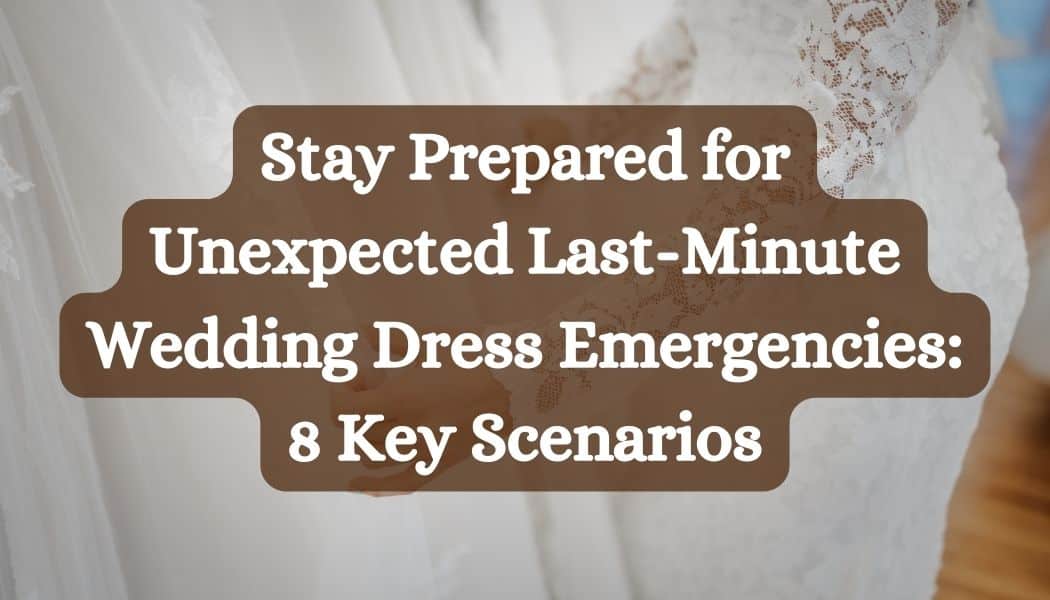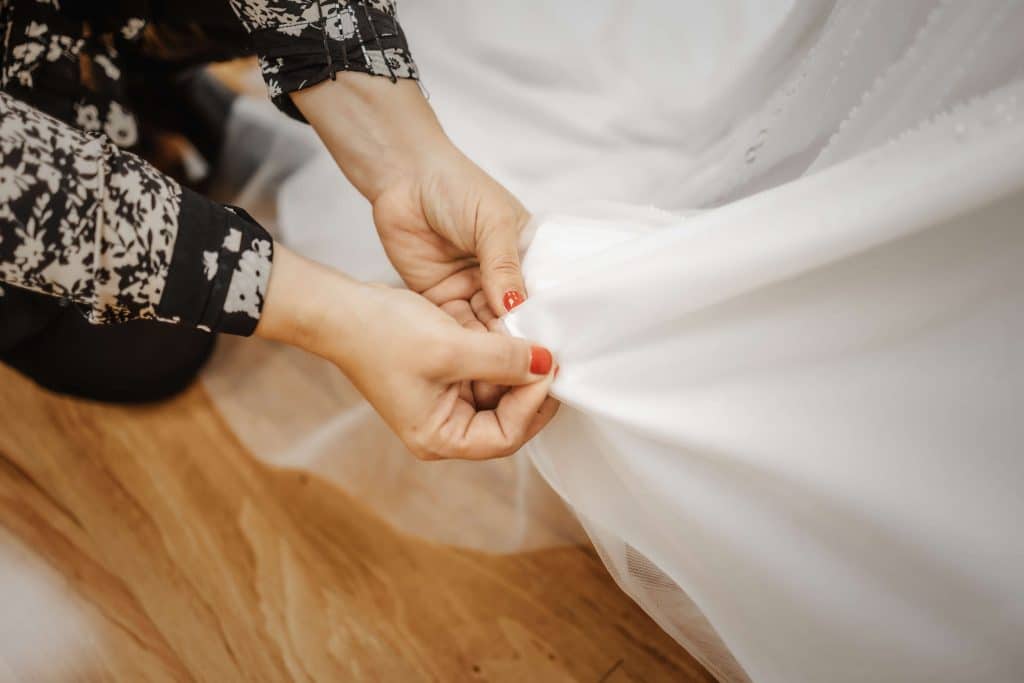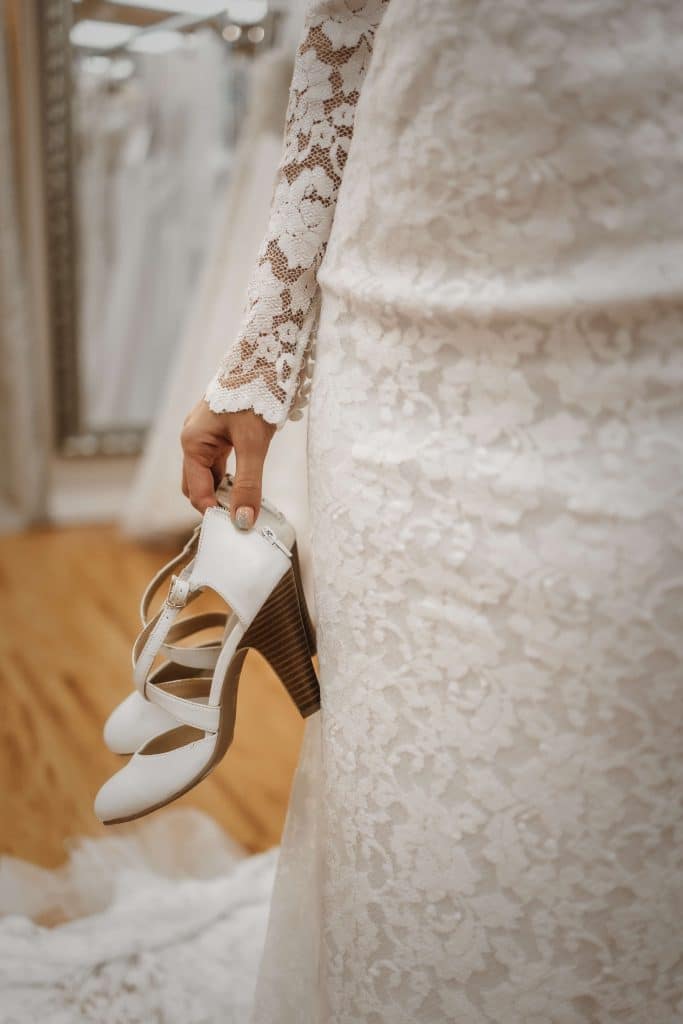
Table of Contents
Key Takeaways
- Wardrobe Malfunctions: Have a sewing kit, fabric glue, and safety pins for rips or broken zippers. Carry fabric tape for tears, and safety pins for bustle issues.
- Stains and Spills: Keep a stain remover pen, club soda, and talcum powder for quick fixes. Use white chalk for stubborn marks.
- Unforeseen Weather Changes: Use waterproof garment bags and umbrellas. Have dress shields and a handheld fan for heat.
- Fit and Comfort Issues: Prepare with body shapers, fashion tape, and cushioned insoles for shoes. Break in wedding shoes and have a backup pair.
- Transportation Troubles: Pack dress with tissue paper in a sturdy case. Use a handheld steamer or a spray bottle to address wrinkles.
- Alteration Problems: Keep contact of a reliable sewist for emergencies. Use double-sided tape for temporary hems.
- Vendor Mishaps: Confirm delivery dates in advance. Have a backup dress and document agreements with vendors.
- Personal Emergencies: Carry a first aid kit, essential medications, and have a support system. Delegate tasks and prioritize self-care.
A wedding day is a tapestry of moments stitched together with joy, love, and anticipation. Yet, like any complex event, it comes with its share of unpredictability. One element that often holds immense emotional value is the wedding dress. An emblem of the day’s significance, its perfection is paramount. However, despite meticulous planning, emergencies can arise. Understanding the importance of preparation for such scenarios can be the difference between distress and composure.
From last-minute alterations gone wrong to unexpected stains or tears, these emergencies can quickly turn a bride’s dream day into a nightmare. Brides can navigate these challenges with grace and confidence by being aware of potential issues and having a backup plan. Whether having a trusted sewist on standby or packing an emergency kit with stain remover and sewing supplies, being prepared can help ensure that the wedding dress remains flawless and the bride remains calm throughout the day. This blog delves into eight typical wedding dress emergencies and offers practical solutions to ensure that when faced with adversity, resilience prevails.
8 Key Scenarios to Stay Prepared For
Wardrobe Malfunctions: Dealing with a ripped seam or a broken zipper
Imagine this: Hours before the ceremony, you notice a seam giving way or hear the dreaded sound of a zipper breaking. Panic is a natural first response, but not your ally. To combat such mishaps, have a sewing kit with thread matching your dress, needles, safety pins, and fabric glue. Quick stitches or securing the area with pins can be discreet lifesavers. For zippers, keep a small bar of soap or wax to smooth over teeth if they catch, or replace the zipper pull with a paperclip in a pinch.
A broken or malfunctioning bustle can disrupt the bride’s movement and overall look. To prevent this from becoming a significant issue, have safety pins or small clips handy to secure the train temporarily. It’s also wise to practice bustling the dress before the big day so you can quickly fix any issues.
A tear or snag in the wedding dress can be devastating. To mend such mishaps, carry a small roll of clear or double-sided fabric tape. These temporary fixes can help hold the torn fabric together until it can be professionally repaired. Carefully use a needle to push the snagged thread back into place for minor snags.

Stains and Spills: Quick fixes for food or drink mishaps
Spills happen, but they don’t have to leave a mark. Blotting—not rubbing—the stain with a white cloth can reduce its impact. To tackle stains and spills, be prepared with a stain remover pen or wipes designed for delicate fabrics. Blot the affected area gently instead of rubbing to avoid spreading the stain.
Every bride should have an emergency kit, including club soda, which removes many stains, and talcum powder for oil-based spills. For red wine, salt can absorb the liquid before it sets. White chalk or a white marker can disguise stubborn marks in a worst-case scenario. Handling delicate fabrics with care and avoiding spreading stains by blotting instead of rubbing is essential. A backup plan, such as a spare dress or fabric, can also be helpful.
Unforeseen Weather Changes: Coping with sudden rain or unexpected heat
Weather can be fickle, and a sudden downpour or heatwave can spell trouble. Protect your gown with a waterproof garment bag for rain, and consider umbrellas for you and the bridal party. In extreme heat, stay hydrated and use dress shields or baby powder to prevent sweat stains. Choose breathable materials if expecting a warm climate, and have a handheld fan ready to keep cool while preserving your look.
The weather can change unexpectedly, and rain or humidity can wreak havoc on a wedding dress. In anticipation of such scenarios, have a waterproof garment bag or plastic cover to protect the dress. Additionally, consider having an emergency kit with an umbrella, towels, and a hairdryer to dry any damp areas quickly.

Fit and Comfort Issues: Managing unexpected weight changes or discomfort
Bodies change, and sometimes, so does the fit of the dress. Body shapers or spandex can provide a smoother silhouette if the dress feels snug. For minor loosening, fashion tape can secure the dress in place. Have a trusted friend or bridesmaid on hand for last-minute adjustments, and make sure they know how to lace up or button the gown appropriately.
Uncomfortable or damaged wedding shoes can make it difficult for the bride to enjoy her special day. Pack some cushioned insoles or gel pads that can easily be inserted into the shoes to alleviate discomfort. Additionally, it’s a good idea to break in wedding shoes before the big day to prevent blisters and sore feet. Consider having a backup pair on standby in emergencies if your shoes are damaged. Remember, comfortable shoes will allow you to embrace and enjoy every moment of your special day fully.
Transportation Troubles: Handling dress wrinkles or damage during transit
Travelling with a wedding dress can lead to damage or wrinkles and creases. Packing the dress in layers of tissue paper can prevent creases, and a sturdy travel case is invaluable. If the dress does sustain damage, assess whether a professional can conceal or fix it quickly. Consider using a garment bag specifically designed for wedding dresses to provide extra protection. Furthermore, it is advisable to avoid placing heavy items on top of the dress while packing, as this can cause damage or distort the gown’s shape. Carry a handheld steamer or a small spray bottle filled with water to smooth out wrinkles and creases. Gently steam or mist the wrinkled areas, then use your hands to smooth them out. Hanging the dress in a steamy bathroom can also help relax the fabric and release wrinkles.
Alteration Problems: Addressing last-minute fitting or alteration issues
Even with the best tailoring, last-minute alterations may be necessary. Have the contact information for a reliable sewist who offers emergency services. Double-sided tape can act as a temporary hem, and removable pads can adjust the fit of a bodice. Be realistic about what can be achieved in the time available, focusing on comfort and function over perfection. Remember to communicate any last-minute alteration needs to the seamstress as soon as possible, providing clear instructions and timelines. Ultimately, prioritize feeling confident and comfortable in your outfit rather than striving for perfection.

Vendor Mishaps: Coping with dress delivery or vendor problems
Vendor errors are a rare but possible challenge. Confirm delivery dates well in advance and maintain open communication with your vendor. In case of delays, a backup dress—either rented or borrowed—can provide peace of mind. Document all agreements with vendors to resolve potential disputes and ensure accountability. Additionally, it’s essential to have a contingency plan in case of any last-minute dress delivery or vendor problems. This could involve having a trusted friend or family member who can assist in finding a solution or contacting alternative vendors if necessary. Remember to stay calm and adaptable, as unexpected challenges can arise even with the most well-planned events.
Personal Emergencies: Dealing with personal health or wellness issues before the big day
Personal emergencies require swift action and support from those around you. Keep a small first aid kit, medications for headaches or stomach upsets, and perhaps most importantly, a calm and caring support system. Remember to eat, drink water, and take moments amidst the whirlwind of activity. Communicating personal health or wellness issues to your support system and delegating tasks if needed is essential. Additionally, consider appointing a trusted friend or family member as a point of contact for emergencies so you can entirely focus on your well-being. Remember that taking care of yourself is crucial to enjoy your big day fully. Taking care of yourself includes getting enough rest leading up to the event and practicing self-care activities such as meditation or exercise. By prioritizing your well-being and having a solid support system in place, you can ensure that you can fully embrace and cherish your special day.
Conclusion
Preparing for wedding dress emergencies equips you to handle the unexpected with grace. Each scenario discussed here highlights the power of readiness. By planning and packing an emergency kit tailored to these common issues, you’ll be more likely to remember your special day for the joy and love shared rather than for any minor mishaps that might occur. No matter how well-prepared you are, it’s important to remember that accidents can still happen. A trusted friend or family member who knows how to handle dress emergencies can provide extra reassurance on your big day. With the right mindset and a little preparation, you can confidently navigate any unexpected situation, ensuring that your wedding day remains a beautiful and unforgettable experience. So here’s to facing the unpredictable, dress intact and head held high, ready to embark on the beautiful marriage journey.
FAQ: Wedding Dress Emergencies
What should I include in my wedding dress emergency kit?
Your emergency kit should contain a sewing kit, fabric glue, safety pins, a stain remover pen, club soda, talcum powder, fabric tape, white chalk, a waterproof garment bag, dress shields, a handheld fan, body shapers, fashion tape, cushioned insoles, a handheld steamer or a spray bottle for water, and a first aid kit with essential medications.
How can I prepare for unexpected weather changes on my wedding day?
To prepare for weather changes, use waterproof garment bags for your dress, have umbrellas ready for rain, and consider dress shields or baby powder for hot weather. Stay hydrated and have a handheld fan for extreme heat.
What do I do if my wedding dress gets stained on the day?
If your dress gets stained, gently blot the stain with a white cloth using a stain remover pen or club soda. For oil-based spills, use talcum powder, and for red wine spills, try salt. In case of stubborn marks, use white chalk or a white marker.
How should I transport my wedding dress to avoid damage?
Transport your wedding dress in a sturdy travel case, ideally a garment bag designed for wedding dresses. Pack the dress with layers of tissue paper to prevent creases. If wrinkles occur, use a handheld steamer or a spray bottle with water to gently smooth them out.
What can I do if there are last-minute fit issues with my dress?
For last-minute fit issues, have body shapers or spandex ready for a snug fit, and fashion tape for minor adjustments. Make sure a friend or bridesmaid is available for quick fixes and knows how to properly lace or button your gown. Consider keeping the contact details of a reliable sewist for emergency alterations.












